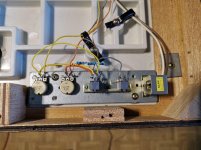Here's the schematic of the turntable. I just refurbished the power supply and servo controller. The 2SD235 is now a 2SD313, and all the electrolytic caps have been switched out including the ones inside the servo motor.
Now I want to add 78 RPM.
Because 33+45=78 what are the chances of just shorting yellow and orange? Otherwise, I've used a AA cell in series to bump the control voltage before, it's just not as elegant.
EDIT: This modification was easy and cost 10 cents. See post #9 (Adding 78 RPM to a Toshiba SR-255?) for details.
Now I want to add 78 RPM.
Because 33+45=78 what are the chances of just shorting yellow and orange? Otherwise, I've used a AA cell in series to bump the control voltage before, it's just not as elegant.
EDIT: This modification was easy and cost 10 cents. See post #9 (Adding 78 RPM to a Toshiba SR-255?) for details.
Attachments
Last edited:
This motor is dedicated to two speeds. No way to get 78/min also. At least not without opening it in order to understand how the internal speed control works.
Best regards!
Best regards!
This motor is dedicated to two speeds. No way to get 78/min also. At least not without opening it in order to understand how the internal speed control works.
Best regards!
It uses an AN620 control chip... I just replaced the capacitors in the servo speed controller... The speed is set by comparing an error voltage apparently...
From a post on Vinyl Engine:
"Hello. Data sheet for AN620 plus other in series never make public available from MEI fabrication plant. Series AN620 is not fabricated by any one other company. Is not available from AD or STM company. Series AN620 original design from 1975 in form of 16 pin LSI and make up from 7 sections. I write some detail below for this.
1] section for SMOOTHING CIRCUIT this change FG signal AC current to DC voltage plus also make filter of signal
2] section for COMPARISON CIRCUIT this make compare DC voltage from 1] section to reference voltage for speed selection. If is any different in voltage then error correction voltage is produced
3] section for SPEED CONTROL this control error current in 3 differential switch circuit section
4] section for 3 DIFFERENTIAL SWITCH CIRCUIT have oscillator plus also control 3 phase secondary current in drive circuit
5] section for DRIVE CIRCUIT plus current limit circuit for motor windings
6] section for hFE COMPENSATION this allow for variation for transistor parameter and most important function for S/N plus wow/flutter performance
7] section for ROTATION SPEED SELECT by methos of external component in addition to AN620"
Yes, the speed controls are both internal pots and external 5K pots as seen on the right side of the diagram...
In Britain, where the mains frequency is 50Hz, the standard was 77.92 rpm.And it's 78.26 RPM... Call it a rounding error.
However, I made a poor joke! 🙁
No worries!
I love the designer of this deck! The 33 RPM switch is physically there but not connected to anything... The speed is controlled by the 45 button only. The 33 button is there to unlatch the 45 button. You can latch BOTH buttons at the same time, too. So as I thought, shorting orange and yellow makes the table spin FAST... Adding roughly 66k4 between orange and yellow make the deck spin at 78 RPM, and the speed can be trimmed with the trimmer for 45 RPM. This is wired through the 33 RPM and 45 RPM buttons to achieve 78 RPM when both button are latched, and pushing either one a little unlatches both.
Amazing 10 cent modification! I used only 3 resistors and a 2 wires.
Here are before and after pics.
Koda
I love the designer of this deck! The 33 RPM switch is physically there but not connected to anything... The speed is controlled by the 45 button only. The 33 button is there to unlatch the 45 button. You can latch BOTH buttons at the same time, too. So as I thought, shorting orange and yellow makes the table spin FAST... Adding roughly 66k4 between orange and yellow make the deck spin at 78 RPM, and the speed can be trimmed with the trimmer for 45 RPM. This is wired through the 33 RPM and 45 RPM buttons to achieve 78 RPM when both button are latched, and pushing either one a little unlatches both.
Amazing 10 cent modification! I used only 3 resistors and a 2 wires.
Here are before and after pics.
Koda
Attachments
I didn't think it would be that easy, for sure. The only other turntables I've added 78 to were belt drive. I just needed to increase the motor voltage (and open the motor to adjust the overspeed mech). I think I used a resistor and a 1.5V battery. Now if only the 70's would come get the old electronics smell out of the motor... 😀
- Status
- Not open for further replies.
- Home
- Source & Line
- Analogue Source
- Adding 78 RPM to a Toshiba SR-255? (SOLVED)


